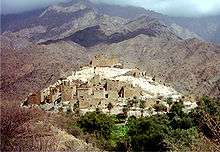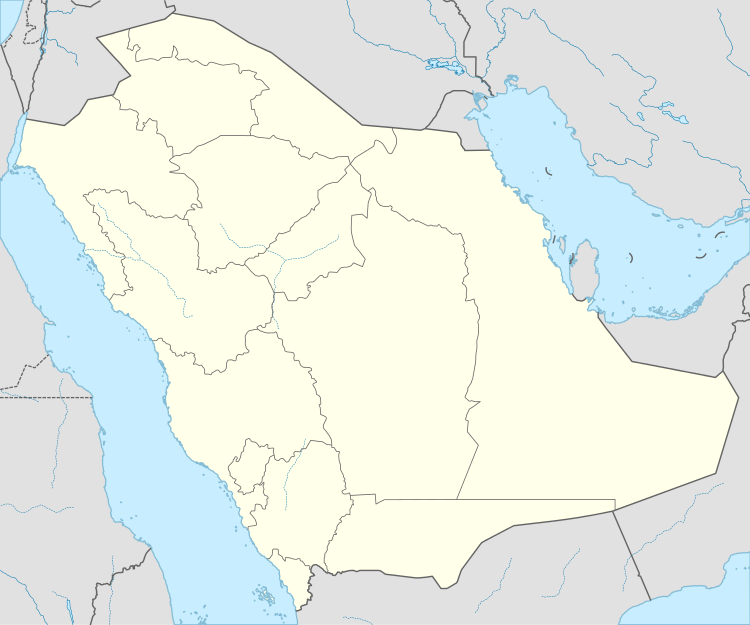Thee Ain
| Arabic: ذي عين | |
 The village from distance | |
 Shown within Saudi Arabia | |
| Location | Saudi Arabia |
|---|---|
| Region | Al Bahah Region |
| Coordinates | 19°46′02.8″N 41°26′03.2″E / 19.767444°N 41.434222°ECoordinates: 19°46′02.8″N 41°26′03.2″E / 19.767444°N 41.434222°E |
The village of Thee Ain (Arabic: ذي عين) in Saudi Arabia is a six-hundred-year-old habitation to the southwest of the city of Makhwah about 20 km from the village. The village includes more than 40 houses and a mosque adjacent to the river. Nearby forts protected them from raids.
Label
The village was named by the name of the water that flows from the nearby mountains without interruption and is poured in several places and each mouth has a certain name. [1] There is a local legend that a man lost his stick in one of the valleys, and to retrieve them may follow them until he arrived in the village and gathered its people and extracted the stick after the excavation of the eye.
Climate change
The climate of the village is hot in summer and mild in winter because it is part of the Tihama area and rises from the sea surface by about 1985 meters, and the rain is heavy in summer and medium in winter.
Description
This village is famous for agricultural crops such as bananas, Kadi, basil, lemon and palm trees, stores, and scenic river.
Osmani provided a history claiming the presence of large quantities of high quality marble and metals. The marble was used during the expansion of the Grand Mosque.
Design of the village
The village consists of 49 houses, of which 9 are single, 19 in two, 11 in three, and 10 in four. The village was built on the Madamek wall system and the walls are approximately 70 to 90 centimeters wide. Sidr wood The large rooms are decorated with columns known as "zafer". Above the Sidr there is a type of stone known as "prayer" and the stones are covered with mud. The lower floors are used for reception, sitting and sleeping floors, and some buildings are still in existence since the beginning of the village and some of them are partially destroyed and some of them are completely destroyed.
Short History
The village was established in the tenth century AH, and witnessed many invasions between the tribes before the unification of the Kingdom by King Abdul Aziz Al Saud. One of the most important invasions against the region was when they met the armies of Zahran and Gamad tribes on the one hand with the army of Muhammad Ali Pasha. Ali Pasha and known tombs as "graves of the Turks".
Rehabilitation of the village
The Saudi Tourism Authority allocated 16 million riyals for the project of rehabilitating the village, which aims to restore and develop the village and turn it into a tourist site. The project was divided into three phases over a period of five years. The first phase included the rehabilitation of the main corridor of the village and the establishment of sessions along the corridor to the waterfall and the reopening of the mosque and rehabilitation of a number of buildings to make it a museum in addition to the establishment of a visitor center and restaurant and public toilets.
External links
- "ذي عين". Theayn.com. Retrieved 2013-05-03.
Reference
^ A B B D "Village of Ain". Saudi Tourism. See it on 19 January 2015. ^ ABT Khalid Khaled (September 9, 2014). "In Pictures .." The Eye "Saudi mythology village that fascinates tourists." Newspaper previously. See it on 19 January 2015. ^ AB "« The eye »archaeological visitors to receive on Eid al-Adha. Al Sharq Newspaper. 6 October 2014. See it on 19 January 2015. ^ "The High Commissioner agrees to apply for the registration of 10 sites on the UNESCO list." Newspaper previously. 15 November 2014. See it on 19 January 2015. ^ ABT "Tourism Authority of the« Middle East »: the transformation of the village of Ein Ain archaeological to a tourist, economic and cultural resource. Al Sharq Al Awsat Newspaper. 5 June 2009. See it on January 19, 2015. ^ "The village of Ain the archaeological .. History overlooking the summit of a white hill." Al Madina Newspaper. 25 January 2012. See it on 19 January 2015. ^ "16 million to complete the development of the village of Ain the heritage." Okaz Newspaper. 28 November 2013. See it on January 19, 2015.
The gate of Saudi Arabia